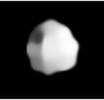18 Melpomene
 | |
| Discovery | |
|---|---|
| Discovered by | John Russell Hind |
| Discovery date | 24 June 1852 |
| Designations | |
| (18) Melpomene | |
| Pronunciation | /mɛlˈpɒmɪniː/[1] |
Named after | Melpomenē |
| Main belt | |
| Adjectives | Melpomenean/mɛlpɒmɪˈniːən/[2] |
| Symbol | |
| Orbital characteristics[3] | |
| Epoch13 September 2023 (JD2453300.5) | |
| Aphelion | 2.797AU(418.4 millionkm) |
| Perihelion | 1.794 AU (268.4 million km) |
| 2.296 AU (343.5 million km) | |
| Eccentricity | 0.21839 |
| 1,270.62 d (3.48 yr) | |
| 0.3995° | |
| Inclination | 10.132° |
| 150.36° | |
| 2023-Sep-11 | |
| 228.15° | |
| EarthMOID | 0.81 AU (121 million km) |
| Physical characteristics | |
| Dimensions | 170 × 155 × 129 km[4] (150 × 125 km)[5] (150 × 170 km)[6] |
| 141±2 km[7] 139.594±2.452 km[3] | |
| Flattening | 0.19[a] |
| Mass | (4.5±0.9)×1018kg[7] 3.0×1018kg[4] |
Meandensity | 3.06±0.62 g/cm3[7] 1.69±0.66 g/cm3[4] |
| 0.48221 d (11.57 h)[3][8] | |
| 0.221 (calculated)[7] 0.223[9] 0.181 ± 0.033[3] | |
| S[3] | |
| 7.5[10]to 12.0 | |
| 6.35[3] | |
| 0.23 "to 0.059" | |
18 Melpomeneis a large, brightmain-beltasteroidthat was discovered byJ. R. Hindon 24 June 1852,[11]and named afterMelpomenē,theMuseoftragedyinGreek mythology.Its historical symbol was a dagger over a star; it is in the pipeline forUnicode17.0 as U+1CECB (![]() ).[12][13]
).[12][13]
Melpomene is classified as anS-type asteroidand is composed ofsilicatesand metals. This asteroid is orbiting theSunat a distance of 2.296AUwith aperiodof 3.48 years and aneccentricity(ovalness) of 0.22. Theorbital planeis tilted at an angle of 10.1° to theplane of the ecliptic.[3]
MelpomeneoccultedthestarSAO 114159 on 11 December 1978. A possible Melpomeneansatellitewith a diameter at least 37 km was detected. The satellite candidate received aprovisional designationS/1978 (18) 1.[14]In 1988 a search for satellites or dust orbiting this asteroid was performed using theUH88telescope at theMauna Kea Observatories,but the effort came up empty.[15]Melpomene was observed with theHubble Space Telescopein 1993. It was able to resolve the asteroid's slightly elongated shape, but no satellites were detected.[5]
Melpomene has been studied byradar.[16]Photometricobservations during 2012 provided arotation periodof11.571±0.001 hwith a brightness variation of0.34±0.02in magnitude, which is consistent with previous studies.[17]It has amean diameterof141±2 km.[7][3]
Melpomene can reach anapparent magnitudeof +7.9 at a favorableoppositionnearperihelion,such as occurred in September 2002 when it was 0.814AU(121.8 millionkm;317LD) from Earth.[18]
Notes
[edit]References
[edit]- ^Noah Webster (1884)A Practical Dictionary of the English Language
- ^Tim Shephard (2014)Echoing Helicon
- ^abcdefghJPL SBDB: 18 Melpomene,NASA Jet Propulsion Laboratory,retrieved20 September2023
- ^abcJim Baer (2008)."Recent Asteroid Mass Determinations".Personal Website. Archived fromthe originalon 2 July 2013.Retrieved27 November2008.
- ^abStorrs, Alex; Weiss; Zellner; Burlsen; et al. (1999)."Imaging Observations of Asteroids with Hubble Space Telescope"(PDF).Icarus.137(2): 260–268.Bibcode:1999Icar..137..260S.doi:10.1006/icar.1999.6047.Archived fromthe original(PDF)on 30 October 2008.Retrieved3 November2008.
- ^Storrs, Alex; Dunne; Conan; Mugnier; et al. (2005)."A closer look at main belt asteroids 1: WF/PC images"(PDF).Icarus.173(2): 409–416.Bibcode:2005Icar..173..409S.doi:10.1016/j.icarus.2004.08.007.Archived fromthe original(PDF)on 10 March 2012.Retrieved26 November2008.
- ^abcdefVernazza, P.; et al. (October 2021)."VLT/SPHERE imaging survey of the largest main-belt asteroids: Final results and synthesis".Astronomy & Astrophysics.54.Bibcode:2021A&A...654A..56V.doi:10.1051/0004-6361/202141781.hdl:10261/263281.A56.
- ^"Lightcurves and Map Data on Numbered Asteroids N° 1 TO 52225".AstroSurf. Archived fromthe originalon 27 November 2005.Retrieved3 November2008.
- ^"Asteroid Data Archive".Planetary Science Institute. Archived fromthe originalon 23 June 2006.Retrieved3 November2008.
- ^Menzel, Donald H.; Pasachoff, Jay M. (1983).A Field Guide to the Stars and Planets(2nd ed.). Boston, MA:Houghton Mifflin.p.391.ISBN0-395-34835-8.
- ^"Numbered Minor Planets 1–5000",Discovery Circumstances,IAU Minor Planet center,retrieved7 April2013.
- ^Bala, Gavin Jared; Miller, Kirk (18 September 2023)."Unicode request for historical asteroid symbols"(PDF).unicode.org.Unicode.Retrieved26 September2023.
- ^Unicode."Proposed New Characters: The Pipeline".unicode.org.The Unicode Consortium.Retrieved6 November2023.
- ^IAUC 3315: 1978 (18) 1; WZ Sge,Central Bureau for Astronomical Telegrams,retrieved5 July2011.
- ^Gradie, J.; Flynn, L. (March 1988), "A Search for Satellites and Dust Belts Around Asteroids: Negative Results",Abstracts of the Lunar and Planetary Science Conference,vol. 19, pp. 405–406,Bibcode:1988LPI....19..405G.
- ^Radar-Detected Asteroids and Comets,NASA/JPL Asteroid Radar Research,retrieved30 October2011.
- ^Pilcher, Frederick (January 2013). "Lightcurves and Derived Rotation Periods for 18 Melpomene 38 Leda, and 465 Alekto".Bulletin of the Minor Planets Section of the Association of Lunar and Planetary Observers.40(1): 33.Bibcode:2013MPBu...40...33P.
- ^"Horizons Batch for September 2002".JPL Horizons.Retrieved17 November2022.
External links
[edit]- 18 MelpomeneatAstDyS-2, Asteroids—Dynamic Site
- 18 Melpomeneat theJPL Small-Body Database

